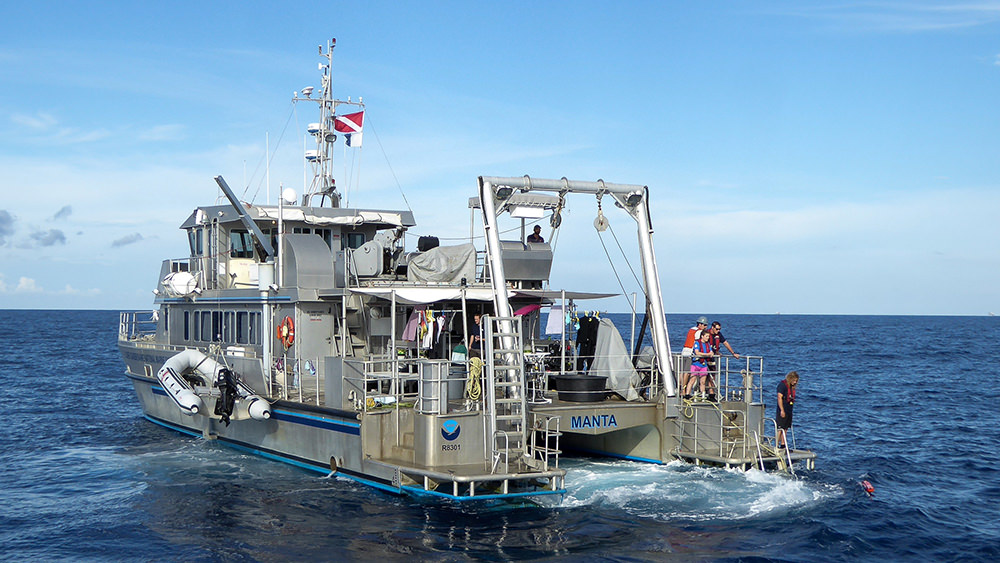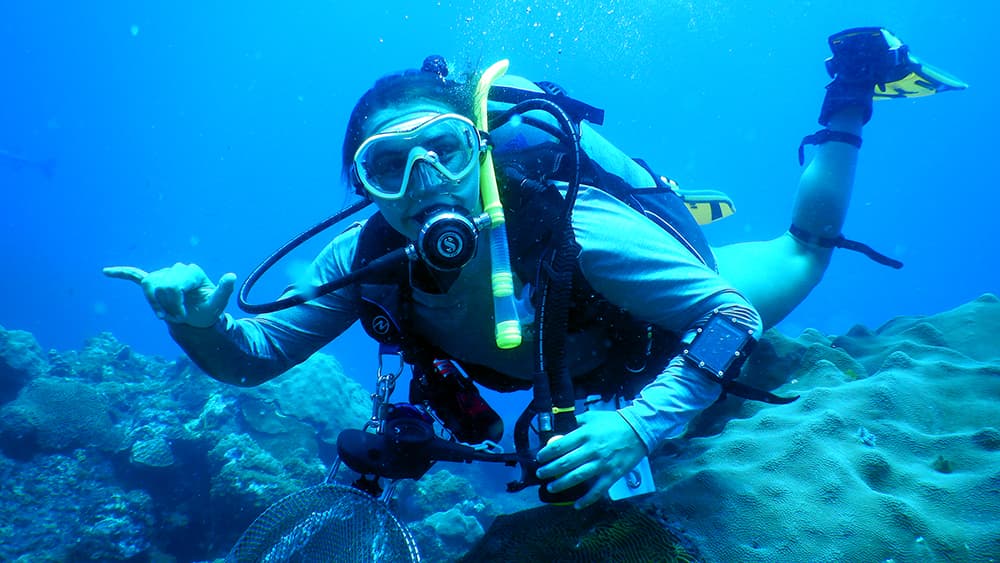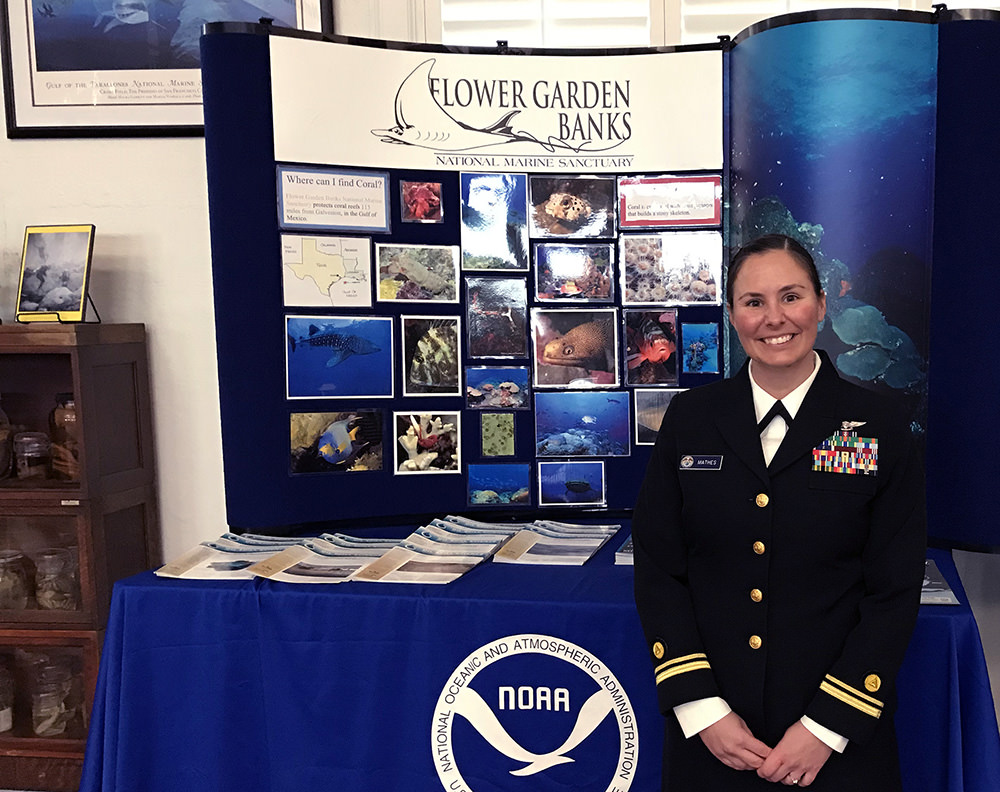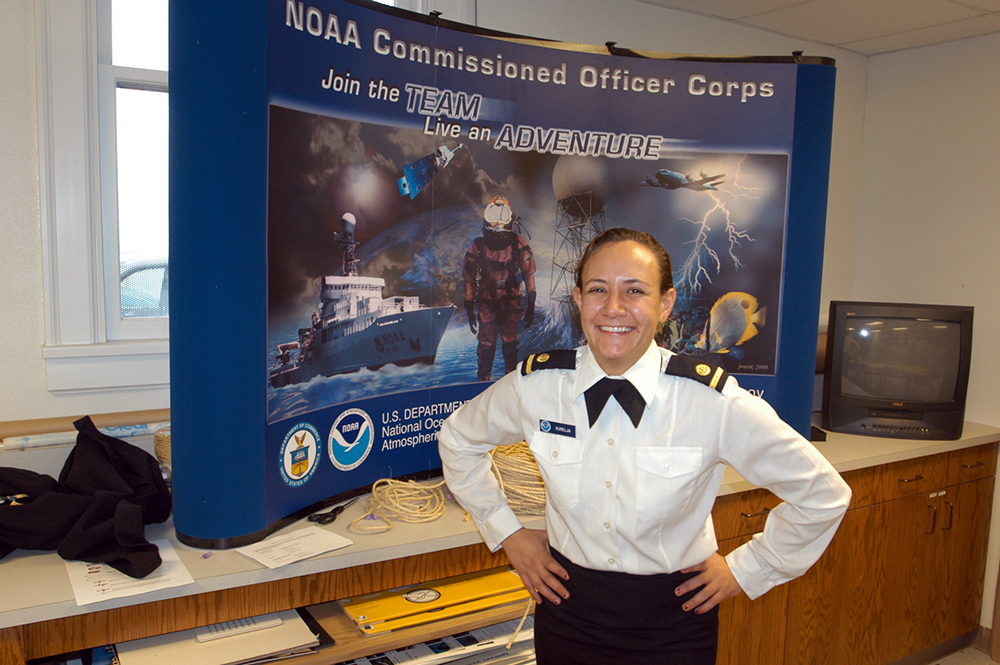
The NOAA Commissioned Officer Corps (NOAA Corps) is the uniformed service of the National Oceanic and Atmospheric Administration (NOAA).
NOAA Corps officers operate ships, fly aircraft, lead mobile field parties, conduct diving operations, manage research projects, and serve in staff positions throughout NOAA. Officers are reassigned every 2-3 years, rotating between shipboard and land-based positions throughout the country.
Here at Flower Garden Banks National Marine Sanctuary, a NOAA Corps officer serves as our Vessel Operations Coordinator, making sure that R/V MANTA remains in good working order and that our overall sanctuary operations are safe and sound.
The sanctuary's first NOAA Corps officer reported for duty in 2004. Following is a brief history of our NOAA Corps staff.
Kaitlyn Brogan (2021-Present)

Background: Kait grew up in Virginia Beach, VA and always loved anything involving the water. She wanted a job that incorporated science and service, which is why the NOAA Corps seemed like the perfect fit. Kait earned a double major in Biology and Geography with a Geographic Information Systems (GIS) certificate and loves studying how biotic and abiotic factors interact with one another to create ecosystems. Before joining FGBNMS, Kait was aboard the NOAA Ship RAINIER helping conduct technical diving operations in the Northwest Hawaiian Islands and surveying the seafloor in the main eight Hawaiian Islands, and SE Alaska updating nautical charts.
Accomplishments: Kait is the current Vessel Operations Coordinator (VOC) and is helping to carry out the FGBNMS missions and research.
Highlights: During my first dive at East Flower Garden bank I was greeted by a manta ray! I had never seen one before in person and it was so fitting for my first dive at the sanctuary to be blessed by the presence of such a majestic creature. I am looking forward to many more opportunities to dive in the sanctuary and to aid in the process of scientific monitoring and discovery.
Melissa Mathes Trede (2019-2021)

Background: Melissa was born and raised in Fort Hood, TX in a proud Army family. After high school, she joined the US Navy where she worked as an Aviation Electronics Technician (AT) on the P-3C Orion and the EA-6B Prowler. She decided to leave the Navy in order to pursue a college degree in hopes of becoming an officer. This brought her home to Texas to attend Texas A&M University at Galveston to focus on her passion of marine biology. During that time she switched to the Army Reserves as an Animal Care Specialist (68T). She also started to volunteer at Flower Garden Banks National Marine Sanctuary where she learned about the NOAA Corps. After graduating, she joined the NOAA Corps and went to sail on NOAA Ship GORDON GUNTER as a junior officer. After her first sea assignment, she went to headquarters in Silver Spring, MD and then was able to come back home to her assignment here at FGBNMS.
Accomplishments: Melissa led the R/V MANTA through one successful field season and then had the difficult job of keeping the boat safe and operational during COVID. She managed to get the boat into the shipyard that year and R/V MANTA remained an operational emergency vessel if needed. She oversaw three shipyard periods (one remotely) and was able to rework the air conditioning system to keep the cabin comfortable for passengers, but also for the many scientific electronics that are brought on board. On a personal note, she also had her beautiful baby boy while on this assignment!
Highlights: "I feel so fortunate that my path crossed with the Vessel Operations Coordinator (VOC) at the Flower Garden Banks while I was in college at Texas A&M Galveston. I learned about NOAA Corps, uncovered a new and exciting career path, and was able to come back to FGBNMS as a part of the team. It was a dream come true! My time there was shorter than most, only two years, and it flew by because I had so much fun!
I had so many wonderful experiences while I was there. I know it might sound silly, but I loved the administrative side of the position. I got a full understanding of what it takes to run a vessel from writing contracts to funding operations. Most importantly I got to work with an incredible crew. My favorite trip was the Global Foundation for Ocean Exploration (GFOE) coral spawning trip by far! It was incredible to see the spawning via the ROV and I loved that we were able to live-stream it to share that experience with everyone. But I really enjoyed driving the R/V MANTA that trip! The boat is so nimble and we had to keep it directly over the ROV as it moved along the coral. It was so technical because we don’t have dynamic positioning, it’s all done by hand. It was a challenge that I was definitely up for! A lot of planning went into that trip and it was worth every moment of it.”
Dustin Picard (2016-2018)

Background: Dustin grew up in a military family with his father serving in the Navy and his mother in the Air Force. After earning a B.S. in Marine Environmental Science and Policy from the University of Maryland, he pursued a career which would combine service and science. The NOAA Corps seemed like a perfect fit.
Accomplishments: During his time at the sanctuary, Dustin coordinated and oversaw 60 projects, including 37 as either a crew member or research diver. He procured and configured offshore internet capabilities for the MANTA, improving communication and overall safety aboard. In addition, he navigated FGBNMS through a new crew contracting mechanism and was responsible for the successful on-boarding of new crew during this turnover. Dustin also successfully led the R/V MANTA and crew through four annual inspections and three annual yard periods.
Highlights:"It's very difficult to pinpoint singular highlights after an outstanding three years here at FGBNMS. I really enjoyed the variety of responsibilities my time as Vessel Operations Coordinator afforded me. The operational and executive skills I have learned here will undoubtedly serve me well during my career.
If I had to narrow it down, my very first mission aboard the R/V MANTA and Mooring Buoy operations stand out for me. During my first ever dive at East Flower Garden Bank, we were greeted by a rather large tiger shark. That encounter, coupled with experiencing the sanctuary for the first time, will stay with me forever. Similarly, Mooring Buoy operations will always be significant for me. The amount of planning, preparation, and teamwork that goes into these missions is astounding. Its hard to describe the feeling of success when these operations run smoothly.
I will forever look back at my time here at FGBNMS favorably!"
Jamie Park (2013-2015)

Background: Jamie grew up in a small town in north Georgia, but gained a love for the ocean at a young age windsurfing with his parents on trips to the Florida coast. He sailed competitively at the University of South Florida while earning a Bachelor of Science in Biology with a concentration in Marine Science. During his time in the Tampa Bay area, he was also a coach and Program Director at the Davis Island Youth Sailing Foundation. It was here that Jamie learned about the NOAA Corps and the opportunity for service it provided.
Accomplishments: Jamie was responsible for the acquisition and installation of R/V MANTA’s Scientific Computer System (SCS), in partnership with Texas A&M University. This data collection system is widely used throughout the NOAA ship and small boat fleets. SCS captures water quality, meteorological and vessel data for use in a wide variety of ways by both NOAA and outside research scientists.
Highlights: "Some of my favorite memories to date as a NOAA Corps officer involve Flower Garden Banks NMS. While aboard NOAA Ship NANCY FOSTER, I had the opportunity to support a 14-day technical diving mission to FGBNMS as a ship driver, small boat operator and in-water safety support diver. That was my first in-person exposure to the sanctuary, and it inspired me to pursue the sanctuary billet. I've had many great trips to the sanctuary aboard R/V MANTA, and my favorites were the 2014 and 2015 coral spawning missions. However, any day at the sanctuary is a great one!"
Marc Weekley (2010-2013)

Background: After spending two years in college in Colorado, Marc decided to take some time off, got certified to teach scuba diving and spent a few years teaching and leading dive trips in the Bahamas, Caribbean and the west coast of Mexico. In 1996 he returned to college to finish a degree, and, upon graduating from University of South Florida in 1999, found a full time position at an environmental lab, as well as two part time positions at The Florida Aquarium in Tampa, FL(Assistant Biologist and Divemaster). In December of 2005, Marc was selected for the next BOTC, and looked forward to a unique and exciting career with the NOAA Corps.
Accomplishments: Marc continued supporting existing projects aboard R/V MANTA such as sediment and hypoxia cruises and ROV operations, and helped out as both a boat captain and diver for the buoy maintenance and long-term monitoring missions. He also worked with the University of Texas to set up mission funding and logistical details for their first missions aboard the MANTA.
Highlights: "In April 2014, NOAA Ship GORDON GUNTER encountered a weather system that was not forecast by either the National Weather Service or the Navy. What was in the forecast, and what we expected, for the those few days were 35-40 knot winds and around 15 foot seas. What we actually encountered were 25-30 foot seas and at least one wind gust of 110 knots. The ship sustained rudder damage and some very tired crew and scientists (nobody got much sleep that day), but otherwise an experience I would have never gotten in an environmental lab!"
Tracy Hamburger (2007-2010)

Background: Tracy grew up in Milwaukee, WI with no boating experience but a love for the outdoors. Trips in high school to Florida and cruises to the Caribbean engaged her interest in our oceans. Tracy ended up attending Texas A&M University at Galveston for Marine Biology, where she joined the Corps of Cadets and gained valuable maritime and leadership experience. After three at-sea summers, Tracy acquired a USCG Third Mates license and was introduced to the NOAA Corps by a shipmate who had sailed on the NOAA Ship GORDON GUNTER as an intern.
Since Tracy's first sea assignment in the NOAA Corps was on the NOAA Ship NANCY FOSTER, she was exposed to East and Gulf coast sanctuaries. She had already worked with the FGBNMS research team, so it was an easy transition when she joined the sanctuary in June 2007.
Accomplishments: Tracy's first duties with the sanctuary included the transport of R/V MANTA from the Pacific Northwest to its home in the Gulf (along with previous Corps officer Lindsay Kurelja), commissioning of the vessel, outfitting the vessel and conducting its operational shakedown. She also participated in some of the first working cruises aboard. Tracy worked closely with Texas A&M University at Galveston to establish a mooring for R/V MANTA, create a pier facility and set up commercial vendors for supply and maintenance in the area.
Highlights: "My most memorable moment was R/V MANTA's maiden voyage from Fort Lauderdale, FL to Galveston, TX. With a small crew of three we sailed her around the Florida Straits making port calls in Key West and St. Petersburg, FL for VIP events and tours. We had her cruising 27 knots across the Gulf to Port Fourchon, LA for a fuel stop and arrived in Galveston to ready her for sanctuary science cruises!
I believe all of the 90 days that the R/V MANTA sailed in its first operational year were successful and set the stage for future operations of the largest sanctuary research vessel. I fully enjoyed working with all of the FGBNMS staff whether it was on a science cruise or participating in an outreach event.
Before the MANTA came online, I was able to sail and dive aboard the live-aboards M/V SPREE and FLING on buoy maintenance and long-term monitoring cruises which were all great experiences.
Lindsay Kurelja (2004-2007)

Background: Lindsay Kurelja hails from the mountain oasis of Estes Park, CO. She ventured to Galveston, TX for education in Marine Biology and Marine Transportation at Texas A&M University at Galveston. During her freshman year, NOAA Ships GORDON GUNTER and OREGON II arrived in Galveston and Lindsay realized that there was a way to participate in data acquisition excellence through dedicated service to the NOAA Corps. She joined the honor ranks of the NOAA Corps in 2002.
Accomplishments: While at Flower Garden Banks National Marine Sanctuary, Lindsay served as the Contracting Officers Technical Representative for the design and construction of R/V MANTA, although she never got to serve on the vessel. She was also the first FGBNMS employee in Galveston, TX and assisted in the commissioning of the offices currently housing FGBNMS staff on the beautiful Ft. Crockett campus. In 2007, she coordinated with the staff of NOAA's Office of Ocean Exploration and Research and a team led by Bob Ballard for the Secrets of the Gulf expedition, that used a naval submarine to explore in the sanctuary.
Highlights: "My favorite moment from my time at FGBNMS was during the Hammerhead Shark migration study in 2006. After being plagued with bad weather and worse visibility on East and West Flower Garden Banks, we transited to Stetson Bank. The weather had calmed and we were cleared to dive. As soon as I put my face in the water, I could see a large school of mackerel schooling. As we descended, the mackerel moved their schooling pattern to circle us.
While watching the small jellies sparkle through the water column, the school of mackerel began to thin. Upon reaching the bottom, we could see the shadows of many hammerhead sharks circling in the opposite direction on the outside of the mackerel school. The mackerel continued to thin out until there were none left and my dive partner and I were at the bottom now being circled by several large male hammerhead sharks.
They continued to close the circle and get closer and closer. One by one the sharks started to approach us, while we floated still and observed their behavior, and then peeled off and disappeared into the abyss. The final shark was a large male. He approached us within 6 feet, passing between my dive partner and I.
As that shark approached, a strange calm passed through the moment and we all knew that this was just a moment of curiosity for both us and the shark. It was the most beautiful experience of communing with nature that I have ever experienced!
I have so many more! The musky smell of corals spawning, the dolphins approaching while on a safety stop, the pride while seeing R/V Manta float for the first time. I could go on forever."

